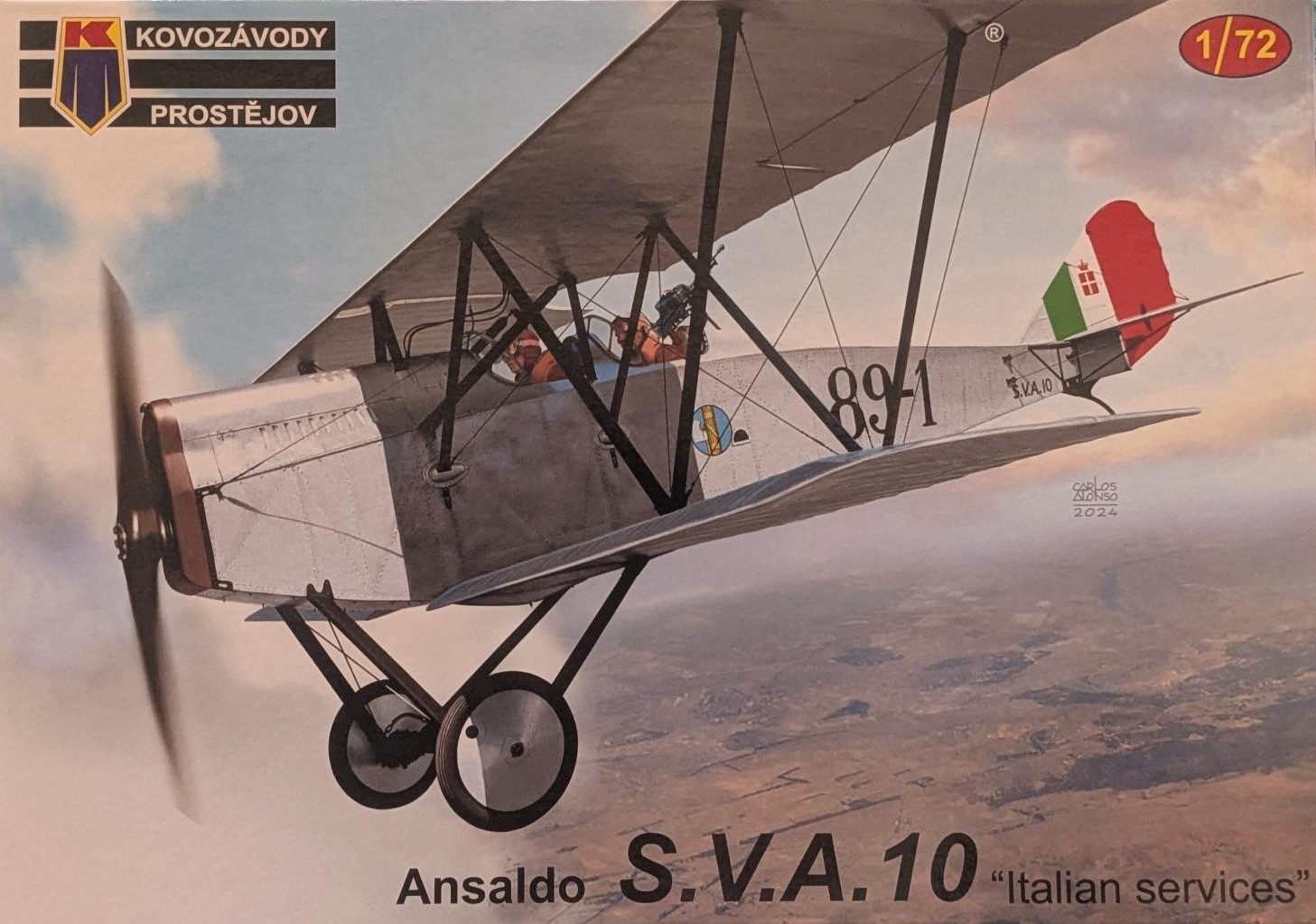Ansaldo S.V.A.10 "Italian Services"
I have long respected WWI era plane modelers. I respect 1/72 WWI era plane modelers even more. And now, I question my sanity after tackling this one. This is not a kit for a novice or even an uninterested intermediate modeler. With the right skill set and some other kits under your belt, and you want an Ansaldo S.V.A. 10, then this is your kit.
The Italian Ansaldo S.V.A. (Savoia-Verduzio-Ansaldo) was an interesting late WWI aircraft. Originally designed as a fighter, the S.V.A. 5 was determined to be inadequate for the role. However, its impressive speed, range and operational ceiling made it an excellent reconnaissance aircraft and light bomber. The S.V.A. 9 and 10 were essentially the same aircraft, with the former primarily an unarmed training aircraft, with its cockpit configured accordingly. The S.V.A. 10 was developed as a reconnaissance and light bomber aircraft that found success during the later stages of WWI and a successful export model in the post-war world.
This Czech Republic model comes in a side opening box containing one large sprue, two separate sprues with two fuselage halves for the two variants, a smaller sprue for the cockpit details, a clear sprue for two windshields and a decal sheet. It appears this model traces its lineage to fellow Czech model maker AZ Models and its 2013 release of the Ansaldo S.V.A 5. The instructions and parts layout are almost the same as the addition of the aforementioned two sets of fuselage halves and cockpit sprue for the S.V.A. 9 and 10 variants. The instructions for this kit are for the KP Ansaldo S.V.A. 9 “Other Services” (Kit No. 72446) and come as a single folded black and white A4 sheet.
The instructions are unclear on the differences between the two variants and cockpit configurations. Take care with small pieces (struts, control stick, etc) as the plastic is fragile and can break when removed from the sprue gates.
There are minor notes that are identified here by their instruction step:
Sprue Layout: No numbers on the parts trees, so use the layout as the parts number guide.
Step 1:
- First decision is which variant will be built. The Ansaldo S.V.A.9 has two seats in line facing forward; the Ansaldo S.V.A.10 has the pilot seat and a machine gunner step facing rearward. The instructions show the fuselage halves for the S.V.A.9 throughout.
- Based on the variant chosen, use the proper fuselage halves: S.V.A.9 are Parts Nos. 31 and 32; S.V.A.10 are Parts Nos. 1 and 2. The instructions point out which fuselage halves to use in Step 2, where it is not obvious.
- Use the left-handed fuselage half locating tabs and holes to assemble the cockpit.
Step 2: The radiator used is based on the variant:
- Ansaldo S.V.A.9 uses Parts Nos. 39 and 20
- Ansaldo S.V.A.10 uses Parts Nos. 38 and 28
Step 5: Part No. 43 appears to be an optional external fuel tank.
Step 6: The struts look like finished origami. Take time to study the box art and instructions to determine the proper location. I used the bottom wing as a starting point, then continually looked at the bottom of the top wing to align the struts to their respective holes. Also, the missing number for the strut is Part No. 4 (looks like No. 5).
Step 7: I still have no idea what the cut in the top wing is for, nor which variant. The instructions show a cut and making spars with melted sprue, but no measurements are given. I studied the box art for the gap and couldn’t find it.
The box art provides painting and decal guides for three Italian aircraft:
- SVA10, “89-1”, Italian Air Force, 1929
- SVA10, “31”, Italian Air Force, 1927
- SVA10, “24436”, Italian Air Force, 1927
I chose the third option as it has a beautiful and unique Egyptian sphinx decal along the rear of the fuselage. Ironically, the instructions provide a color callout, but no reference to the colors in the instructions or the box art (which has basic color callouts with no specific nomenclature).
The decals are very delicate and initially conformed well to the model with just water. To be clear, that was my initial impression as several decals shattered and pulled apart as they were drying. I used Micro-Sol and that also initially helped. The decals then set properly, except for both the flank fuselage roundels of the Regia Aeronautica, which spit and separated. After the decals dried, I applied a gloss coat for weathering, and the wing roundels bubbled.
There are also no rigging instructions or diagrams to make this requisite step a reality. The modeler will have to research on their own, but fortunately, rigging is at a minimum with this aircraft.
A few things to make this kit easier would be to include masks or scale size painting guide to make the lines clean and correct in shape. Alas, no pilot figure is included, which makes it hard for an in-flight model.
If you want a unique WWI aircraft, then KP Models has you covered. There are three other boxings for the Ansaldo S.VA. 9 and 10 models that appear to have the same base kit with different decal options:
- Ansaldo S.V.A. 9 “Italian Eagles”
- Ansaldo S.V.A. 9 “Other Services” with Chile, Poland and Netherlands decals
- Ansaldo S.V.A. 10 “Other Services” with Czechoslovak, Latvian and Polish decals
In the hands of experienced small-scale biplane modelers, this will build into an amazing kit and fills a gap in this era of aircraft.
Profuse thanks to Kovozávody Prostějov and IPMS/USA for providing the review sample.












Comments
Add new comment
This site is protected by reCAPTCHA and the Google Privacy Policy and Terms of Service apply.
Similar Reviews